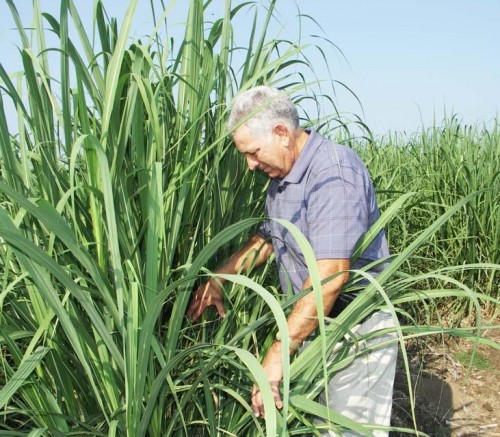Thursday, June 16
June 16, 2011
Jennie Pizzolato Dato
June 20, 2011Before the first commercially processed shrimp was produced on Grand Terre Island in 1867 or the first oil well was drilled at Evangeline in 1901, sugar cane farming and science had taken root in Louisiana.
Among the U.S. sugar cane producing areas, Louisiana is the oldest, and only because of a slightly shorter growing season, today ranks second behind Florida in total annual production, which was more than 11.5 million tons in 2010.
Jesuit priests brought sugarcane to Louisiana in 1751. The research of Etienne deBore in 1795 resulted in the first granulated sugar to be produced and marketed.
Sugar cane production in Louisiana today includes 400,000 acres in 23 parishes. But it was in Terrebonne Parish during the early part of the 20th century, it could be argued, that detailed scientific research was born – or at least grew from its infancy.
A complex of diseases reached epidemic proportions during the 1920s. Sugar cane production was severely hampered and the industry was in trouble. Southdown Plantation, owned at that time by the Minor family, called the federal government for assistance.
Researchers arrived in Terrebonne Parish to look at the problem. Scientists compared the sugar cane variety being victimized by disease to similar grasses and eventually found a plant resistant to the problem disease located in Java, modern day Indonesia.
The new variety was brought to Louisiana, crossbred with existing plants, proved successful and saved the domestic sugar cane industry.
Recognizing the importance of dedicated research for this crop, the owners of Southdown Plantation donated 25 acres of property to become the U. S. Department of Agriculture Sugar Cane Research Laboratory, located across Little Bayou Black from La. Highway 311 near Lafayette Street.
Lead researcher and location coordinator Edward Richard has admitted that although the stately white “main house” building, constructed between 1936 and 1938, along with the smaller original research house that dates back to 1928, greenhouses and rows of sugarcane samples are easily noticed by drivers that pass it every day, most people have no idea what it is or what the 45 government employees that work there do.
“Basically, we tell growers what to expect,” Richard said during a tour of the facility. “Our efforts are mostly developing sugar cane varieties for the sugar industry of Louisiana. But some of the material we are working on has broader implications.”
Richard explained that like most crops there are multiple varieties of sugar cane. Thirty-seven recognized species offer a starting point.
At the Houma-based research laboratory, new hybrids are being developed to fight specific diseases and infestations without the need of pesticides. Some varieties are also being developed that could enhance growing areas into cooler climates and require less fertilizer.
“To make these hybrids, we take wild species that don’t have any sugar and cross them with types that do have sugar,” Richard said. “We then have a hybrid that has the same [durability] characteristics of the wild sugar cane. We have to do that maybe three or four times. It is a long process to get [the right combination] and can take 30 years.”
For sugarcane that successfully grows in Louisiana, the crossing of plant hybrids was a 13 year process.
While much had been made of corn becoming a bio-fuel supplement to the petroleum industry, researchers contend that sugar cane offers greater promise both in terms of productivity and price. This is another area of study at the Sugarcane Research Laboratory.
“Sugar cane is a major potential crop for the production of bio-fuel, not only from sugar, but from the fiber component,” Richard said. “It is the most efficient crop we can grow to produce fuel.”
Richard explained that the input of corn vs. its fuel value means that for every one unit of sunlight energy in processed corn, the yield offers 1.7 units of reusable energy. By contrast, with sugar cane, every unit of sunlight energy offers 8 units of reusable energy.
“We are making a fast growing hybrid we are calling energy cane,” Richard said. “It doesn’t have a lot of sugar in it, but it does have a lot of fiber. It’s what a lot of these technologies are looking for.”
Corporations including BP, Chevron and DuPont have expressed interest in sugar cane as a bio-fuel and the energy cane being developed in Terrebonne Parish.
“What is stymieing a lot of time is that when the price of gasoline goes up, the interest [in sugar cane as a bio-fuel] goes up,” Richard said. “When the price of gasoline falls, the interest goes down.”
“We look at bio-fuel as an opportunity to look toward the future,” American Sugar Cane League General Manager Jim Simon said. Based in Thibodaux, ASCL representatives contend that although bio-fuel is not a short term alternative for growers, it does offer future possibilities for an industry challenged in the arena of product consumption by chemical alternative sweeteners and public perceptions regarding sugar.
According to a LSU report, international trade has been cited as a threat to the domestic sugar industry. The loss of price support as the United States competes in the global market has resulted in a decline of basic exports as cheaper products from other countries, including processed sugar, are chosen over higher priced American goods.
Granulated sugar was once considered a luxury item. The refining of processed sugar carried over to being an expression used to identify those that could afford the product, as being refined.
In time processed sugar became affordable to the masses, but it was attacked by health groups during the last quarter century and challenged during seasons when production costs outweighed market earnings.
Richard and Simon agree that the future of the sugar industry depends on continued research and alternative product development.
During the past 40 years, Louisiana sugar cane production hit its high point in 1999 with a gross yield of 37 tons per acre. The market saw a steady decline to 26 tons per acre in 2005 and fluctuated in production during the next five seasons.
“Our industry right now is in as good of shape as it has been in a number of years,” Simon said. “We have been fortunate to enjoy the last two years of decent prices, which were preceded by some 20 years of level pricing.”
During the first week of June, domestic raw sugar was priced between 33 cents and 35 cents per pound. “From that perspective we’re doing pretty good,” Simon said.
Even with a prolonged dry spell, Simon said that growers are in position to experience a good crop, provided that the hope for some steady rain is not taken to an extreme during hurricane season.
“What would really be helpful [to growers] is if we could figure out a way to create value in the by-product we produce,” Simon said.
Richard and Simon agreed that creative and expanded use of the raw product offer a secret to success for the sugar industry. With that comes the requirement of enhanced research.
The USDA Sugar Cane Research Laboratory has long recognized the need to upgrade their facilities. In addition to the main campus, an additional 150 acre lab has been established on La. Highway 311 at Bull Run Road.
In 2004 the federal government began appropriating money for the construction of a new $17 million facility. Although one $8 million lab and plant research has been established in a phasing in process at the new location, budget cuts have put the overall expansion on hold.
“We need a more modern [main] building, but it will be a while,” Richard said.
Among the oldest commercial agricultural ventures in Louisiana, the sugar cane industry has overcome multiple challenges because of research. It is the science behind farming that both Richard and Simon contend will keep the business growing.
USDA Sugarcane Research Leader Edward Richard checks a sampling of the newest sugar cane variety that has been developed. The Houma-based facility is leading the way in fighting diseases that impact sugar crops as well as combining varieties in an effort to develop bio-fuels. MIKE NIXON











